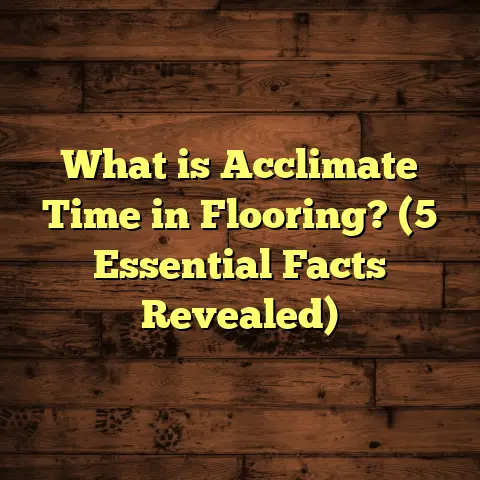What is this sticky stuff on our concrete floor? (5 Easy Fixes!)
When I first noticed that sticky stuff on my concrete floor, I was pretty puzzled. It wasn’t just a little patch here and there—it felt like someone spilled syrup all over the place. I wondered, “What is this? How did it get here? And, most importantly, how do I fix it without turning the whole floor upside down?” If you’ve ever found yourself in the same sticky situation, stick around. I’m going to walk you through everything I learned, from what that gooey mess actually is to some easy ways to get rid of it.
What Is This Sticky Stuff on Our Concrete Floor?
So, what exactly is this sticky stuff? Often, it’s a residue left behind by construction materials, adhesives, or even chemical spills. In my experience, it usually falls into one of these categories:
- Adhesive Residue: Leftover glue or bonding agents used during flooring installation or repairs.
- Curing Compounds: Chemicals applied to fresh concrete to help it harden properly.
- Spilled Substances: Anything from paint to cleaning products that dried sticky.
- Environmental Deposits: Sap, grease, or even sugary spills that accidentally made their way onto the floor.
I remember when I was working on a basement renovation project. The contractor used a curing compound on the newly poured slab to prevent cracking. A few days later, a thin sticky layer appeared, which was quite frustrating because it attracted dirt and was tough on bare feet.
This sticky layer isn’t just annoying—it can cause safety issues too. Slipping on a slick surface or having debris stick to your shoes can lead to accidents. Plus, it’s just plain ugly and makes your space feel unclean.
Why Concrete Floors Are Susceptible
Concrete is naturally porous. That means it has tiny holes and spaces where liquids and solids can settle in. This porosity varies depending on the mix design, curing process, and finishing techniques. When sticky substances contact the surface, they seep into these pores and bind with the concrete matrix.
This is why simply wiping with a cloth often doesn’t work. The substance isn’t just sitting on top; it’s embedded inside the surface layers.
Concrete’s texture also plays a role. Rougher surfaces have more area for sticky stuff to cling to, while polished or sealed concrete tends to resist adhesion better.
The Science Behind Stickiness
Sticky residues often contain polymers or organic molecules with adhesive properties. For example:
- Acrylics and polyurethanes in curing compounds form thin films that bond tightly.
- Epoxy-based adhesives chemically react with surface minerals.
- Sugars and resins from natural sources create tacky deposits.
- Oils and greases have hydrophobic properties that attract dirt and dust.
Understanding what the substance is made of helps determine the best removal method. Acidic cleaners work well on some organic residues but can damage concrete if too strong. Mechanical removal may be necessary for polymerized layers.
Common Causes of Sticky Substance on Concrete Floors
Here’s a deeper look into what can cause that sticky mess:
Adhesive Residues from Flooring Installation
If you’ve installed carpet tiles, vinyl planks, or laminate flooring over concrete before, you’re familiar with adhesives. These glues are designed to bond strongly but sometimes leave residue behind, especially if excess glue was used or not cleaned up properly.
In one project where I installed vinyl flooring in a kitchen, leftover adhesive pooled in corners and became tacky over time due to moisture absorption. This required special attention during cleanup.
Curing Compounds and Sealers
Curing compounds are sprayed onto fresh concrete to prevent moisture loss during hardening. While effective at protecting the slab, these compounds sometimes don’t fully dry or get washed off before foot traffic starts.
I once dealt with a gym floor where improper curing compound application left a slippery, sticky film that caused athletes to slip repeatedly until the floor was treated properly.
Similarly, some sealers applied incorrectly can leave a tacky finish instead of a smooth protective coat.
Paints, Sealants, and Coatings
Accidental spills of paint or sealer can leave sticky patches if not cleaned immediately. I remember a case where a contractor spilled some acrylic paint thinner on a warehouse floor—once dry, it became gummy and attracted dirt badly.
Environmental Factors: Sap, Grease, and Oil
Outdoor concrete floors near trees or machinery are often victims of sap drips or oil leaks. These natural and industrial substances form stubborn sticky patches that attract grime.
Household Substances and Spills
Sugary drinks, food residue, or cleaning chemicals accidentally spilled on garage or basement floors can dry sticky. I once found soda syrup stains in a basement workshop that took days to scrub away.
How Sticky Floors Affect Your Home or Business
Sticky floors aren’t just ugly. They affect daily life in multiple ways:
- Safety Risks: Sticky surfaces increase chances of slipping or tripping.
- Unhygienic Conditions: Dirt sticks easily leading to dirty footprints and difficult cleaning.
- Floor Damage: Sticky residues can interfere with sealers and coatings causing premature wear.
- Reduced Comfort: Walking barefoot or playing sports on sticky floors is unpleasant.
- Negative Impression: Whether at home or business, sticky floors send a message of neglect.
A study from a facility safety board found that 17% of workplace slip-and-fall accidents involved floors contaminated with residues like adhesives or oils.
5 Easy Fixes to Remove Sticky Stuff From Concrete Floors
Here’s where things get practical. Over years of working with concrete floors, I’ve tried numerous approaches. Some worked fast; others took effort but gave lasting results.
1. Soap and Warm Water – A Basic Yet Effective Start
For light stickiness caused by spills like sugar or mild residues, soap and warm water often do the trick.
- Mix warm water with a few drops of dish soap.
- Mop or scrub the affected area gently using a stiff brush.
- Rinse thoroughly with clean water to avoid soap film buildup.
This method saved me loads of time cleaning up syrupy spills in my own garage. It won’t work for hardened adhesives but softens fresh messes well.
2. Vinegar Solution – Nature’s Cleaner
Vinegar is mildly acidic and breaks down many sticky substances effectively without harsh chemicals.
- Mix equal parts white vinegar and water.
- Apply to sticky spots and let sit for 5–10 minutes.
- Scrub with a stiff brush.
- Rinse well afterward.
Vinegar worked wonders removing tree sap from my patio concrete last spring without damaging the surface.
3. Commercial Adhesive Removers – For Tough Jobs
When dealing with hardened adhesives or curing compounds, specialized removers are your best bet.
- Buy a remover formulated for concrete use (read labels carefully).
- Follow application instructions closely.
- Work in ventilated areas and wear gloves for safety.
In a warehouse floor project last year, we used an industrial-grade remover that dissolved tough adhesive layers within an hour, drastically reducing manual labor.
4. Scraping and Mechanical Removal – When Chemicals Aren’t Enough
Some sticky substances bond too tightly for chemicals alone.
- Use a putty knife or scraper for small patches.
- For large areas, rent a floor grinder or buffer with abrasive pads.
Start with fine grit abrasives to avoid surface damage. Mechanical methods require care but are highly effective.
Once I had to grind down a factory floor coated with multiple layers of sticky sealers—painful but necessary for restoration.
5. Power Washing – Outdoor Surfaces Benefit Most
If you’re dealing with outdoor concrete patios, driveways, or factory yards:
- Rent a power washer with adjustable pressure.
- Spray at an angle for better residue lift.
- Avoid excessive pressure that could erode concrete surface.
Power washing cleared years of grease buildup from an auto shop’s concrete apron in less than half a day.
Step-by-Step Removal Guide Based On What You’re Facing
Here’s how I recommend deciding what fix to try first:
| Type of Sticky Substance | Recommended First Step | If Not Removed Try |
|---|---|---|
| Light spill residue (sugar/syrup) | Soap & warm water | Vinegar solution |
| Tree sap/organic residues | Vinegar solution | Scraper + soap |
| Adhesive residue | Commercial adhesive remover | Scraper + mechanical grinding |
| Curing compound | Commercial remover + scrubbing | Mechanical grinding |
| Oil/grease | Power washing + detergent | Degreaser + mechanical cleaning |
How Long Does It Take To Remove Sticky Residue?
Time varies widely based on:
- The type of residue
- Size of affected area
- Tools and products used
- Surface condition (sealed vs unsealed)
For example:
- Soap & water can take 30 minutes to 2 hours for small areas.
- Vinegar treatments might require repeated applications over days.
- Commercial removers usually act within 30 mins–2 hours.
- Mechanical grinding may take days for large projects.
- Power washing depends on surface size but often works quickly outdoors.
When I was tasked with cleaning a 3000 sq ft warehouse floor covered in adhesive residue, we pre-treated overnight with remover then ground the surface over three days for complete restoration.
Personal Story: The Basement Renovation That Taught Me About Sticky Floors
I’ll share one experience that really stuck with me (pun intended). During my own basement renovation years ago, after pouring a new slab, I noticed a thin film started forming within days — it felt like plastic wrap stuck on the concrete.
Turns out the contractor applied curing compound but didn’t wash it off properly before starting work. The sticky layer trapped dust and made walking barefoot miserable.
I tried scrubbing with soap and water—no luck. Then vinegar solution softened it somewhat but didn’t remove fully. Finally, I bought an adhesive remover recommended for concrete and followed up with careful scrubbing using a nylon brush.
The difference was night and day. The floor became smooth again without damage. That hands-on experience helped me understand how important proper curing compound application and cleanup are after pouring concrete slabs.
Preventing Sticky Residue On Your Concrete Floors
Prevention beats cure every time. Here’s what I recommend based on my projects:
Seal Your Concrete Properly
Sealing fills pores and creates a protective barrier against spills and adhesives. Use penetrating sealers early after curing for best results.
Clean Spills Immediately
Don’t let sugary drinks or chemicals sit long enough to soak into pores. Quick cleanup prevents stickiness from developing.
Avoid Applying Adhesives Directly On Bare Concrete
If you must use adhesives over concrete (e.g., for flooring), consider using underlayments or primers designed to reduce residue buildup.
Maintain Regular Cleaning Routines
Use gentle cleaners weekly to prevent accumulation of grime that can mix into sticky patches later.
Understanding Concrete Porosity: Why Some Floors Get Stickier Than Others
Porosity plays a huge role in whether your concrete floor will attract sticky stuff easily:
- Low water-to-cement mixes produce denser slabs with fewer pores.
- Quick curing (especially in hot/dry climates) increases porosity due to rapid moisture loss.
- Polished or sealed concrete drastically reduces porosity compared to broom-finished slabs.
In one project comparing two warehouse slabs poured side-by-side but cured differently, the dense slab resisted adhesive buildup while the porous one became problematic within months.
You can test porosity by dropping water droplets: if they absorb quickly leaving dark spots, porosity is high.
Materials Science Behind Adhesive Bonding To Concrete
Adhesives bond chemically via:
- Mechanical interlocking into pores
- Chemical reactions forming covalent bonds
- Surface tension forces trapping molecules tightly
Polymer-based adhesives cure by cross-linking chains creating durable films resistant to water and solvents once hardened—this explains why they’re so tough to remove once dry on concrete surfaces.
Knowing this helps pick appropriate solvents—solvents that break cross-links are more effective but often harsh; milder acids/bases work better on organic residues but won’t touch cured polymers.
Case Study: Restoring Sticky Warehouse Floors To Safe Condition
A warehouse I consulted on had persistent sticky patches impacting worker safety. Investigations revealed:
- Multiple layers of adhesive residue from past flooring installations
- Poorly cleaned curing compounds from recent slab pours
- Oil drips from machinery mixing with adhesive making thick grime
We created a multi-step plan:
- Pre-treatment with commercial adhesive remover
- Mechanical scrubbing using rotary floor machines
- Power washing
- Application of penetrating sealer for protection
After two weeks of work, slip incidents dropped substantially; workers reported much cleaner floors; the client saved $12K by restoring instead of replacing floors.
Tools You Might Need To Tackle Sticky Concrete Floors Yourself
Here’s what I usually keep handy:
| Tool/Material | Purpose |
|---|---|
| Stiff nylon brush | Scrubbing stuck-on residues |
| Putty knife/scraper | Removing thick glue patches |
| Mop & bucket | Cleaning solution application |
| Floor buffer/grinder | Mechanical abrasion for large areas |
| Power washer | Outdoor grease/oil removal |
| Protective gloves | Safety during chemical usage |
| Commercial adhesive remover | Dissolving tough polymer residues |
Knowing which tool fits your situation saves time and effort.
Environmental & Safety Considerations When Removing Sticky Residues
Always keep these in mind:
- Use chemical removers in well-ventilated areas.
- Wear gloves and eye protection.
- Dispose of waste water according to local regulations (especially if solvents are involved).
- Test any chemical cleaner on small inconspicuous spot first to avoid discoloration or damage.
During one job inside an office building, we had to coordinate ventilation carefully due to odor issues from adhesive removers—planning ahead avoids headaches.
My Final Thoughts On Tackling Sticky Stuff On Concrete Floors
Dealing with sticky floors was one of those unexpected headaches in my work that taught me patience and versatility. Whether you’re tackling a small basement spill or managing large industrial floors, there’s always a way forward.
If you catch that sticky stuff early and pick the right method based on what caused it, you’ll save yourself time and frustration. Remember: start simple with soap and water before moving up the ladder of fixes until your concrete feels smooth and clean again.
Have you ever dealt with this kind of problem? What worked for you? Feel free to share—I’m always curious about new tricks!
If you want me to add even more sections like detailed DIY step-by-step instructions for each fix method or deeper technical analysis on chemical interactions between adhesives and concrete surfaces, just let me know!





